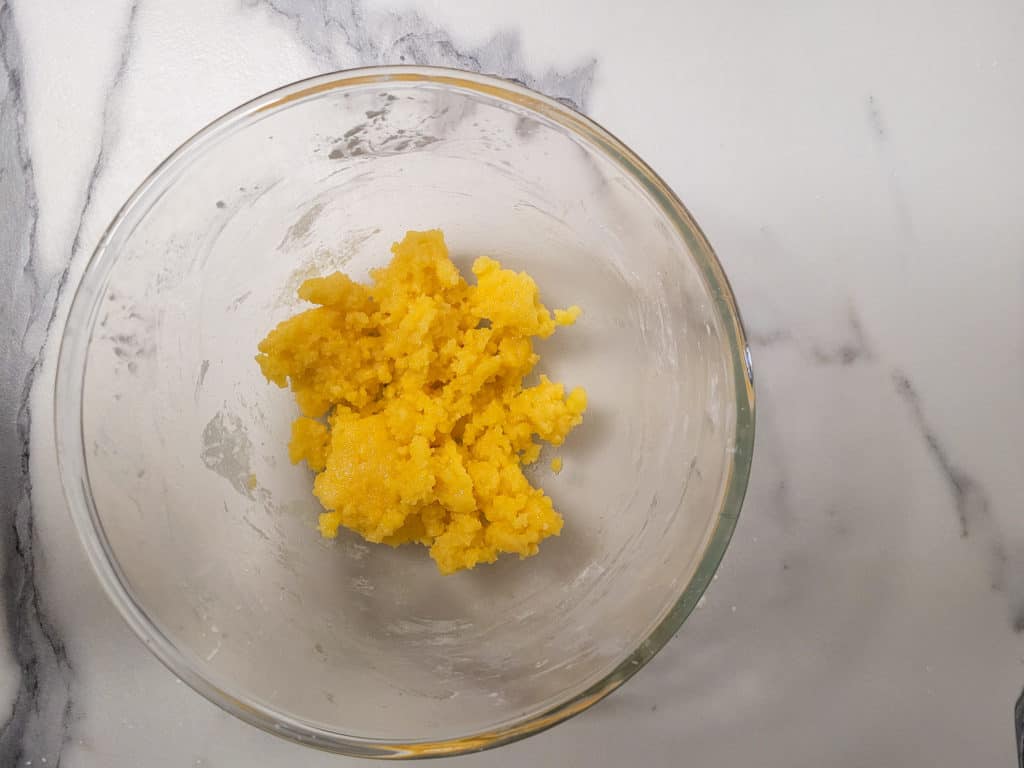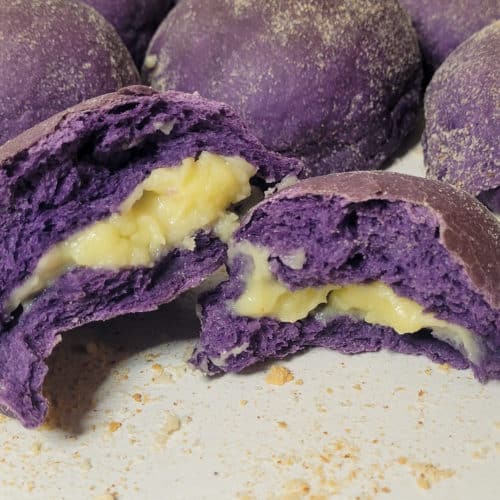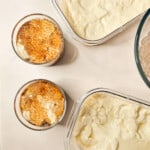Disclosure: Some of the links in this post are affiliate links. This means if you click on the link and purchase an item, Sees Food, Will Travel will earn a commission at no extra cost to you. See terms and conditions for details.
This ube pandesal with custard unexpectedly settled cravings I didn't know I had. As soon as I bit into one of these warm, freshly baked buns, it gave me a level of comfort I didn't think I needed! The slightly earthy ube flavor within the fluffy pandesal mixed with a dose of creamy custard makes you want to cuddle up on the couch with a mug of hot coffee and not move for the rest of the day.

It isn't easy to find the real thing all the way here in Tbilisi, Georgia. So I had to ship some ube extract to myself from the United States. As much as I wanted to use ube halaya (jam), I was nervous about the jar bursting open en route. This recipe ended up only using one ube ingredient, which is an extract. Even though I had to make do with what was available to me, the extract was a great choice in this streamlined recipe, and I believe I achieved my goal!
What is Ube?
I'm sure you have seen some of the intensely purple food variations floating around the internet since ube has taken the world by storm. I think it started with ube ice cream sold in mass at Trader Joe's that introduced people to the versatility of the purple yam that all Filipinos have grown up loving. Now, ube is a specialty flavor in cookies, tarts, pies, and pretty much anything sweet and delicious! Ube is a purple yam indigenous in Asia but cultivated as a major crop in the Philippines. They are narrow-shaped tubers with purplish brown skin and purple meat. In the Philippines, ube is used in various dishes, most often produced in the form of ube halaya, or ube jam made with butter, milk (evaporated/condensed), and sugar.
What is Pandesal?
Pandesal is the most common yeasted bread roll sold in bakeries alongside ensaymada, Spanish rolls, and Kababayan bread. Considered mainly a morning treat, Filipinos purchase pandesal for reheating over the next few days. It's typically devoured with slabs of margarine slathered between soft toasted slices. Another popular option is to add a thick slice of cheddar or Edam cheese to your pandesal!
Pandesal Plus Ube Plus Custard
Ube pandesal has been circulating in the mainstream food scene since ube became popular. There are many recipe versions providing instructions on how to make ube pandesal depending on what type of ube flavoring or ingredient you have available in your pantry. I also decided to add a luscious custard filling to the ube pandesal! This custard will not harden during baking and makes for a pleasant surprise at the center of your pandesal!
How to Make Ube Pandesal with Custard
Make the Custard Filling
Before making anything else, you have to make the custard filling because it takes a while to set. In a bowl, melt the butter in the milk by heating it in the microwave for no more than two minutes. In a separate bowl, mix together egg yolks, flour, sugar, salt, and cornstarch.

Add one-third of the milk/butter mixture to the other bowl of ingredients and whisk until lumps have disappeared. Repeat until all of the milk/butter mixture has incorporated into the other ingredients.

Take a saucepan and pour the custard mix through a sieve to eliminate large chunks of egg.

Then place the saucepan on low heat and stir with a whisk as it heats up. You will start to see the custard thicken and when it starts forming soft peaks, remove it from the heat. Continue stirring until it forms stiff peaks since it continues cooking from residual heat.

Pour the custard into a clean bowl, cover it and let it set in the fridge for a few hours. Tip The custard will not harden. It is ready when it reaches the consistency of a thick pudding that maintains its shape when scooped. This is so we can achieve a soft custard, similar to a thicker cream puff filling.

Make the Yeast Starter
As with all yeasted bread, begin with making the yeast starter by mixing the warm milk, two teaspoons of sugar, and active dry yeast in a bowl. Mix them until the yeast has melted. Set it aside to rise for ten minutes until you see a foam skimming the top of the milk.
Add the egg yolk and melted butter, then whisk them until well incorporated. Here is where you will add the ube extract. I used one teaspoon of ube extract for my recipe, but I encourage you to add as many as three teaspoons (one tablespoon) for a stronger flavor. I wanted to highlight the taste of the custard for this recipe, so 1 teaspoon of ube provides a very mild flavor.

Make the Ube Pandesal Dough
In a separate large bowl, add salt, the rest of the sugar, and flour, then mix to incorporate. Pour the yeast starter into the dry ingredients.

Using dough hooks, knead the dough until it has become elastic and soft. The dough is ready when you can easily make a smooth ball. Place it in a bowl and cover to proof for up to an hour or when it doubles in size.

Assemble
De-gas the dough after it has proofed, making sure all air bubbles are released.

Shape the dough into a donut, then split it apart at one section so you end up with a single log of dough. Slice the dough log into 12 equal pieces, then shape them into balls.


Take one piece and roll it out while keeping the center thick. Spoon some custard into the middle of the dough and then carefully pinch the edges together to seal the bun. Roll the sealed bun in a container filled with breadcrumbs making sure it's fully coated, then place it on a lined baking sheet.



Tip Before rolling the pandesal in breadcrumbs, you can brush the bread roll with milk. The milk coating will make a softer and chewier pandesal crust.
When you are finished assembling the pandesal, proof it a second time for about another hour or until it doubles in size. When you have about fifteen minutes of proofing time left, preheat the oven to 180°C (350°F).
Place the bread rolls in the oven and bake them for fifteen minutes. Once you remove them, you can cool the pandesal for about five to ten minutes. They are best enjoyed when they are still warm!

Options for Your Ube Pandesal
I used a minimal amount of ube extract for my pandesal because I wanted the custard to be the main attraction. If you intend on simply making ube pandesal without the filling, I recommend you use as much as a tablespoon and if you want it even stronger, add even another teaspoon. Play around with your preference, and you will find your sweet spot!

Ube Pandesal With Custard
Disclosure
The equipment and ingredients sections contain affiliate links to products I love to use as well as items that I personally believe make this recipe the best version of itself.
Ingredients
Pandesal
- 1½ teaspoon active dry yeast
- 200 grams milk, warm
- 50 grams granulated sugar 2 teaspoons set aside for yeast mix
- 1 egg yolk
- 400 grams all-purpose flour
- 55 grams unsalted butter, melted
- 1 teaspoon salt
- 1 teaspoon - 1 tablespoon ube extract If making plain ube pandesal, use at least 1 tablespoon
- 60 grams breadcrumbs
Custard Filling
- 215 grams milk
- 40 grams unsalted butter, melted
- 2 egg yolks
- 50 grams granulated sugar
- 2 tablespoon all-purpose flour
- 1 tablespoon cornstarch
- ¼ teaspoon salt
Instructions
Make the Custard
- Mix the melted butter and warm milk in a bowl, set aside
- In a separate bowl, whisk together egg yolks, flour, salt, sugar, and cornstarch
- Pour ⅓ of the butter/milk mixture into the bowl of egg yolks and whisk until no lumps remain, repeat until all the butter/milk is incorporated with the egg yolk mix
- Pour into a saucepan through a sieve and cook on low heat while stirring, it will start to slowly thicken so continue stirring to avoid lumps
- Once the custard has soft peaks, remove from heat and continue stirring until it forms stiff peaks
- Pour into a clean bowl and put in the refrigerator for up to 4 hours until it has completely set.
Make the Pandesal
- In a bowl, add warm milk, 2 teaspoon of sugar, and yeast. Allow to sit until frothy.
- Add flour, the rest of the sugar, and salt then whisk. Set aside.
- When the bowl of yeast has started to bubble, add melted butter, egg yolk, and ube extract. Whisk together then add to the bowl of dry ingredients.
- Using dough hooks, knead for up to 8 minutes until you can form a smooth ball. Once it's ready, place into a bowl and cover to proof for 1 hour or until it has doubled in sized.
Assembly
- Once the dough has doubled in size, let out the gas and divide into 12 equal pieces and form into balls.
- Flatten the pandesal dough and add a scoop of custard - about 2 teaspoon - in the center. Then pinch the edges together to seal the dough.
- Roll each pandesal gently into the breadcrumbs and place on a lined baking sheet
- Let the rolls rise until double in size, about 40 minutes to an hour.
Baking
- While the rolls are going through their second proof, preheat the oven to 180°C (350°F)
- Place the pandesal in the oven when it's ready and bake for 12-15 minutes or until slightly browned.
Have You Tried This Recipe?
Simply rate the recipe by clicking on the ⭐️s on the recipe card. Have something to say? Please leave me a comment down below telling me what you think of this recipe.
Bonus: Let me and other readers know what you did to make this recipe your own - 💫 let's inspire each other!
Also, follow me on Instagram [@seesfoodwilltravel] and send me a DM with a picture of what you made. I would love to share and celebrate YOUR creation with our budding community 💞
Check out Sees Food, Will Travel on Pinterest and Facebook for more delicious updates.






Leave a Reply